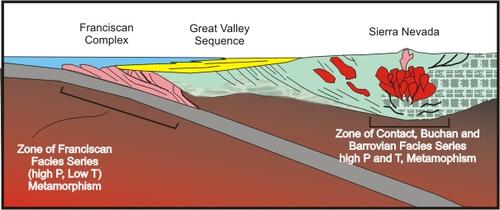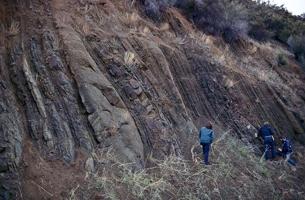1.b Paired Metamorphic Belts
Metamorphic belt, Fanciscan Complex
Image Credit: MBG
Franciscan melange in the Central Valley of California.
Image Credit: Bruce Molnia, US Geological Survey. AGI
In 1961, Miyashiro noted that belts of high-pressure / low-temperature metamorphism on the oceanic side in the Circum-Pacific region were associated with belts of high-pressure / high-temperature metamorphism on the continental side. He termed such occurrences Paired Metamorphic Belts. Two examples include Japan, where the Sanbagawa Belt represents the high-pressure/low-temperature belt, and the adjacent Ryoke-Abukuma Belt, representing the low-pressure/high-temperature belt. The Ryoke-Abukuma belt consists of Barrovian- and Buchan-facies series metamorphic rocks. The other example is represented by the western U.S., where the Franciscan complex contains rocks metamorphosed at high pressure and low temperature, whereas rocks exposed in the Klamath Mountains and Sierra Nevada Mountains expose remnants of Barrovian- and Buchan-facies series metamorphic rocks.
ther occurrences of paired belts have since been recognized throughout the world and include areas in New Zealand, Indonesia, Washington State in the U.S., Chile, Jamaica., the Alps of central Europe and the northern coast of South America.
Most of these areas show evidence of having been associated with convergent plate margins, where subduction has occurred. It appears that subduction is necessary to produce the low geothermal gradient necessary to form the belt of high pressure and low temperature. Such belts are quite rarely preserved in the geologic record due to the presence of hydrous minerals during blueschist-facies metamorphism. An exception takes place when these rocks are uplifted and exposed at the surface relatively fast after subduction ceases so that these rock units are able to escape being overprinted by facies of a normal geothermal gradient, as there would be still fluids available to form the greenschist- and amphibolite-facies mineral assemblages.
The high-pressure, high-temperature belts are expected to form in areas beneath the island arc or continental margin volcanic arc. During emplacement of the arc, these areas are subject to higher-than-normal geothermal gradients that could produce Buchan-facies series metamorphic rocks. Furthermore, emplacement of batholiths and isostatic adjustment after magmatism has ceased due to the fact that these belts of high-T, high-P metamorphism were uplifted and exposed at the surface.
In the case of the Japanese paired belts, the two belts are adjacent to one another likely because subduction has moved farther off the coast. Compressional tectonics between the Pacific and Eurasian Plate has accreted the island arc and trench complex to Japan at the end of the Mesozoic.
In the case of the western U.S., the paired belts are separated from one another. This is because the oceanic ridge that existed off the western coast of North America was subducted, and the margin changed from dominated by compression and subduction to a transform-fault margin dominated by strike-slip faulting. Isostatic rebound of the highly deformed Franciscan Complex has resulted in its exposure at the surface.
Noch einzuarbeitender Bildkommentar zu Bild Franciscan:
Figure: Franciscan melange in the Central Valley of California. A melange is a mappable body of rock that includes fragments and blocks of all sizes, embedded in a generally sheared matrix. Franciscan melanges usually contain rare minerals that are formed during deformation. Source: Bruce Molnia, US Geological Survey. AGI



